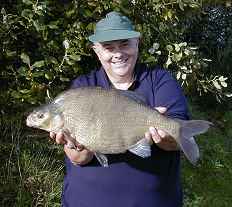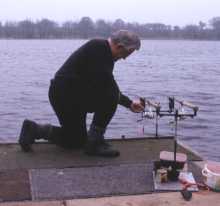How many carp anglers free-line today? How many use a running lead? Not many, I’ll bet. The strive for sensitivity when carp fishing ended a long time ago. The success of the bolt-rig put an end to that. And like many modern methods innovated by carp anglers the bolt-rig now has a place in fishing for almost all species at some time or other, including bream. The secret of success is knowing when that time is apt, and how far to go with it.
Let’s go back a few years, to the days when we used bite indicators as simple as a fold of flake on a loop of line between butt ring and reel. And the time when you used a lead that was just, and only just, heavy enough to reach the swim. Everyone always struggled for maximum sensitivity, to the point where it was against your instincts and frustrating having to fish with a heavier lead in order to cast to a distant swim in windy conditions, and the butt indicator (of whatever type) was constantly crawling to the butt-ring as a result of undertow. So reluctant were we to increase the weight of the lead or the indicator we drove ourselves mad trying to decide what was a bite and what was a pull from undertow. We had been completely brainwashed into thinking that the lightest and most sensitive was always best. How wrong we were.


One of the greatest disadvantages of fishing too light and too sensitive for big bream, apart from the fact that you don’t hook as many fish, is that most of the time you don’t realise you have a bite unless the fish runs directly away from you. Drop-back bites just don’t register, for the bobbin, or other light indicator, simply does not have sufficient weight to drop when the line falls slack. Drop-back bites are a particular peculiarity of big bream too, which is not surprising when you consider the shape of a bream and what it has to do to take food off the bottom.
The action of a bream taking food off the bottom is the same as that of any bottom feeding fish, except that the bream’s movement is more exaggerated. Also, bream spend more time cleaning a bait than most other fish, sucking and blowing repeatedly until they segregate the morsel they want from the debris it lay amongst. Not surprising when you consider that bream habitually feed where the silt is thickest and the bloodworm and other edible creatures are at their most abundant. They also blow at the bottom to dislodge small food items and so make it easier to pick them off. The sequence of events when bream decide to feed is that the bream grazes along the bottom, sucking and blowing at the bottom to release interesting tit-bits as it goes, cleaning, tasting and probing for something that takes its fancy. It can do this from an almost even keel, for the bream has eyes that look downwards and lips that are angled downwards too. When it comes across something that it really wants to consume, something that will not be sucked in easily, it tilts down to it and sucks from a shorter distance, or actually picks it up with its lips. To tilt back to an even keel it has to move a considerable distance; the bigger the bream the greater that distance is. And that movement is as near as dammit as vertical as you’re going to get. A light set-up, especially when using a long hook tail, will cause that movement to transmit through to the indicator, for the line will follow the curve through the water, through and beyond the link, and move the indicator.
Striking at that indication will sometimes result in a hooked fish, but there are many other times when it won’t, and that will be those instances when the indicator has moved simply because the bream has sucked at the bait, then rejected it by blowing it out, and then repeats this action several times over. Both sucking and blowing at the bait cause the indicator to rise, for any movement of the line will transmit to the indicator as a pull. The fact that bream spend so much time cleaning food with this frequent sucking and blowing gives rise to the fact that many bream bites are missed – they simply do not have the bait in their mouths many times when the indicator is moving. Even when the indicator has travelled a foot or more this can be nothing less than an accumulation of sucks and blows that all cause positive movements of a light indicator, usually all in the same direction.
Resistance, and the lack of free travel between bait and lead, is the key, for when these elements are offered the bream is given a simple choice: take the bait firmly, or reject it totally. A full bolt-rig is often too much for bream, ie, a hefty (2oz plus) fixed lead direct on the line, but what I can only describe as a semi bolt-rig is usually most acceptable. This is offered by fishing a somewhat heavier than normal lead (1oz to 1.5oz even at short range) on a short link (7ins to 10ins), which is the same as the main line, 6lb, and a short hook length (4ins to 6ins) which is 5lb. Everything is connected together via a swivel, and I incorporate a length of 0.5mm rig tube above the swivel as an anti-tangle measure and a line protector at that point. This is shrink-tubed to the swivel and stopped with a large rubber float stop at the other end.
There is no point fishing a short hook length with a very light lead, for the fish will shift the lead too easily once the free travel of the hook length is taken up. Remember that I am talking about big bream, hefty fish of at least 8lb and usually much bigger, although the same principles apply to smaller bream, only to a lesser degree. Smaller fish will have a correspondingly less powerful vacuuming action and will therefore need lighter leads and longer hook lengths to deal with them.


Line bites then come into the equation. For those who are not sure what these are, they are movements of the indicator caused by fish brushing against the line somewhere between the lead and the rod, and often picking line up on a fin and running with it. Striking at line bites can result in fish being foul-hooked, with the result that you spook the whole shoal and ruin your chances until the next feeding spell. In the case of big bream this can be anything from 24 to 48 hours or more later, depending on how well they fed before they were spooked, and if the water temperature is suitable thereafter. The bottom line (pardon the pun) is that you avoid line bites like the plague. Or, you take a risk finding out as quickly as possible if the indications you are getting are line bites, rather than it being a case of you missing genuine bites. If you make that choice you strike at all movements of the indicator at first, until you realise they’re line bites, and hope you don’t spook the fish. Or you tackle up in a way that avoids line bites registering at the indicator, thus preventing you from striking at them.
The middle ground, however, is that you can try to establish why you’re getting line bites and hopefully do something about it. Contrary to popular opinion, line bites are not always caused by a big shoal of fish that is passing through the swim, or between you and the swim. They can be caused just as easily by a small group of fish that are milling about in the swim, or between you and the swim, rather than passing through. Very often it is a group of fish that are interested in the free feed you have laid down for them, but are not yet hungry enough to feed on it. The first thing to do when you suspect line bites, especially when using a three-rod set-up, is to cast two of the rods at shorter range, one, say, three yards closer, and the other six yards closer, and then leap frog these until the bites either stop, or you connect with fish. Once you have established where the line bites are happening, you can cast different baits into that area and try to tempt a fish or two. Although I must confess that you invariably fail in these circumstances, for persistently ‘line-biting’ fish are very rarely feeding fish.
Carp anglers, and I include myself in the following when I’m carp fishing, are inclined to use back-leads to avoid their quarry fouling the line between rod and end tackle. Back-leads are slid onto the line following casting and run down the line to the bottom, and thus pin the line to the bottom from that point not far from the rod tip to the end tackle. I’ve tried back-leads when bream fishing but I don’t like them. I don’t think bream are a powerful enough fish to ‘deal’ with them. These days, when the bream I’m fishing for run well into double figures, I am more inclined to use a set-up that does not register line bites, a set-up like the semi bolt-rig I’ve described earlier. With such a rig the bream can still foul the line, but the difference is that you don’t know about it, and are not going to strike ‘just in case’ it’s a genuine bite.
That, in my view, is the most important reason for using the semi bolt-rig when fishing for big bream – only genuine bites will be indicated, preventing one striking at false bites that could spook all the fish in, or near, the swim. That the semi bolt-rig is partly a self-hooking rig is a bonus, and it also follows that a self-hooking rig promotes more relaxed, less intense fishing, particularly through the night when one bite from one big fish is usually all you can hope for, and that is the cream on the cake.
Specially when you’re getting on a bit and have trouble keeping your eyes open!










